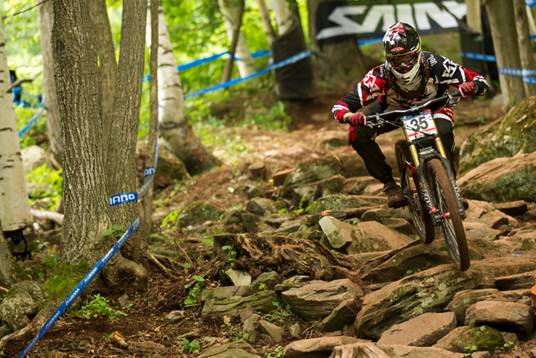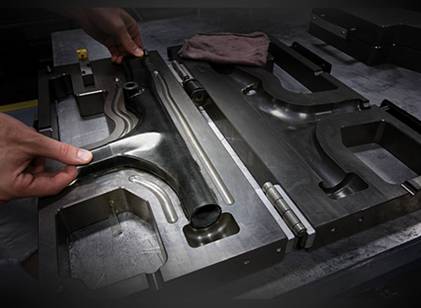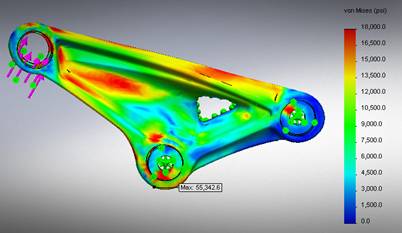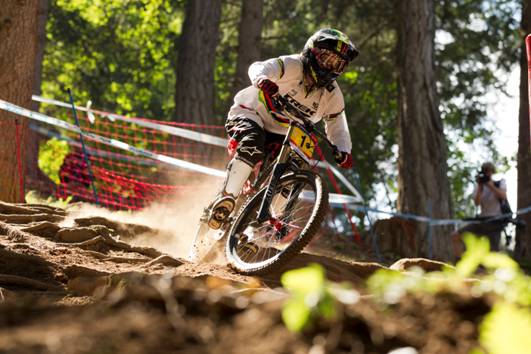Using the latest tools from SolidWorks, Nvidia, and Dell, Trek designed a new mountain racing bike that took top honors in 2011.
Trek Bicycle Corporation is a leading manufacturer of world-class mountain racing bikes. Like manufacturers in other fields, Trek is being pushed by competition to create products that are sturdy yet lightweight. It also needs to maintain a competitive edge by reducing time to market. For its latest championship bike Trek relied on state-of-the-art engineering tools from SolidWorks, Nvidia, and Dell Computer.

Trek, located in Waterloo, Wisconsin, recently introduced Carbon Session 9.9, the lightest downhill mountain bike ever made; it retails for $8,900. Bicycle production presents conflicting design goals common among many manufacturers today. The product has to be as light as possible and as sturdy as possible to withstand the heavy demands the rider will put on the bike. “On top of it all, the bike has to look good, from its structure and styling to every detail of its functionality,” says Michael Hammond, a senior industrial designer who leads the design team for Trek’s Mountain Bike division. “Every element of our products is clearly visible.”
Trek’s previous generation, the Session 88, featured an aluminum frame and was the fastest downhill bike when it was introduced in 2008. Since then, other companies have introduced their own contenders and Trek’s competitive gap has tightened. The Trek team had to figure out how to use advanced materials and patented OCLV (Optimum Compaction, Low Void) technology to create a cutting edge product that picked up where the Session 88 left off.

They needed to translate the geometry of the aluminum frame into the lighter but notoriously more fragile and costly carbon fiber material, balancing speed and durability into a downhill racer’s dream bike.
Working with carbon fiber
Using carbon fiber would allow Trek to achieve many of its goals, however, carbon fiber bikes are much more complicated to design and build than aluminum ones. Sheets of carbon “fabric” have to be laid, by hand, into open-back steel molds, according to a precise layout schedule. The molds are closed and pressure is applied to create each part. Designing the exacting layout, as well as determining the specs and complicated surfacing for carbon bikes, is a sophisticated process.
To overcome this challenge, Trek used Dassault Systèmes SolidWorks on Quadro-powered Dell Precision mobile workstations. According to Hammond, “We knew we had a lot to handle in creating such a complicated product and had little time to do it. So we wanted to be able to get to as many design iterations as we could and not get bogged down. The great thing is that everything works with Quadro.”
Once they had the initial parameters for the new bike, it took the Trek team only four months to go from first sketch to physical prototype, with about 20 concepts tested and simulated. Before using Nvidia Quadro GPUs to design their products, they took twice as long to get to the prototype stage and could only test a handful of concepts during the same timeframe.

Previously, the Trek team needed to do full frame model printouts (SLA prototypes) four or more times per project to see the level of surface detail required to perfect everything before building the prototype. Each printout cost upward of $2,000 and took at least a week to complete. The simulation tools allowed Trek to skip the printouts and directly save those costs.
Getting the prototype right the first time is also critical to help lower design expenses. It costs tens of thousands of dollars to set up the tooling for a new frame design, and that’s assuming no corrections or re-tooling is needed. The ability to make and simulate changes quickly and to see minute details clearly allowed the Trek team to limit their efforts to a single, just-right prototype—saving tens of thousands of dollars.
The value of simulation
“Being able to see surface deviations and transitions right away in our models and simulations, without losing performance, was critical,” continued Hammond. “Previously, we couldn’t render fast enough to do that detailed checking in software for things like clearance issues for the crank, wheels and derailleurs, or to project the strength of various frame segments. By powering 3D simulations in SolidWorks, the Quadro cards let us see hot spots in the frame structure right away, so we could fix them immediately and not have costly rework later. Faster iterations in simulation meant we were able to design the bike more cost-effectively and get to tool prototype much faster.”

Hammond points out, “Every week we are delayed in getting a bike into production, we’re losing money in potential sales, and with the Carbon Session 9.9, it was important competitively to be out there fast.”
Riding the new Carbon Session 9.9 bike, pro downhill racer Aaron Gwin won the overall World Cup Championship in 2011. “I think the Carbon Session 9.9 is a step ahead of any other bike that’s out there, which is just a big advantage confidence-wise when you get to a race knowing you have the best bike to ride,” said Gwin.
“We succeeded with the Carbon Session 9.9 in building the best carbon fiber downhill racing bike ever introduced, and we couldn’t have done it without the speed and quality of the Quadro GPU,” concluded Hammond. “The great thing is, we can use these same Quadro-powered tools to improve the quality and time-to-market of all our products.”






